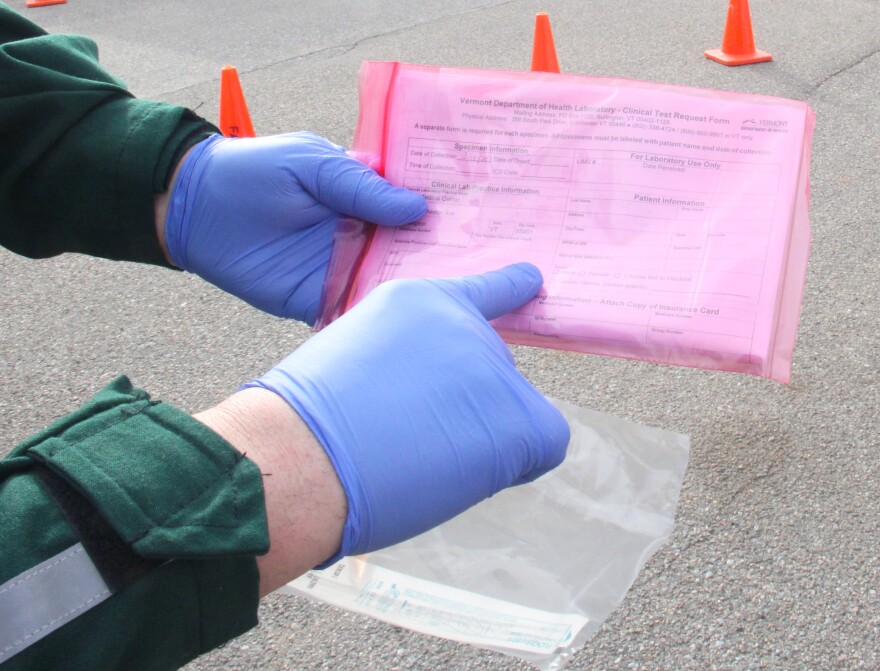There are 22 confirmed cases of COVID-19 in Vermont and, as of Thursday, the state has conducted 667 tests for the disease.
Around the state, facilities like Porter Hospital in Middlebury and Southwestern Vermont Medical Center in Bennington are offering drive-up coronavirus testing for patients with referrals. The University of Vermont Medical Center opened a drive-thru testing site this week, and it’s been busy ever since.
When you drive into the Champlain Valley Expo in Essex Junction where the pop-up testing site is located, you take a hard right and drive through a gate in a chain link fence. Ahead, there are empty buildings and open fields: Normally, in a few months’ time, there would be rides, deep-fried foods and games.
Sign up to receive email updates from VPR and NPR about the coronavirus here.
But on Wednesday, the grounds were empty – except for an outpost in the middle, where a large ambulance was parked and orange traffic cones marked a lane for arriving patients. The testing site is open from 10 a.m. to 4 p.m., seven days a week. And on its first day, 21 patients came through. By Wednesday, the third day of operations, there were 72.
Only patients with referrals from a doctor can get a test right now.
When VPR visited, there were are no patients at the site. The hospital won’t let reporters in during operating hours due to privacy concerns. But Randy Lanier, a community paramedic, was there to show reporters the process.

It goes like this: When a car arrives, Lanier, wearing a mask and gloves, walks up and opens a big binder. In it are instructions printed in big letters.
“So roll the windows up,” he said, flipping through the pages in the binder. “Turn your recirculator on so that keeps all the air inside and place your identification in the window. … then I’ll take that information back up to the ambulance where we’ll get the lab kits.”
The patient, still in the car, then drives forward into a white canvas tent where a paramedic, like Lanier, takes the sample. When they do it, they’re wearing protective gear, including a mask, face shield and gown — and they change into a new set of protective gear for each new patient.
The actual process of collecting the sample is a nasal swab, and according to Lanier, it’s not pleasant.
"It goes all the way back to where the back of your nose meets your throat, so it’s very far back there — it’s an extraordinarily uncomfortable test," he said.
Once the sample is taken, the patient drives off, and the sample goes into a cooler.
“This is where we’ll hold them 'til the end of the day, when we take them to the lab at the end of the day to get tested,” Lanier said.

Mike Conti, the program manager for the critical care transport team, said the whole process takes five to 10 minutes. The goal is to lessen the burden on emergency rooms and urgent care, where people can wait for hours, according to Conti.
“If we can go through and get people that are appropriate for this process through [here] and to get back to the comfort of their home … then that’s what we want to do,” he said.
From the fairgrounds in Essex Junction, the samples go to the state’s public health lab, a sprawling building in a Colchester business park just off of Interstate 89. That's where Cheryl Achilles, the microbiology program chief, said the samples undergo what's essentially a two-step test.
Find a list of FAQs about the new coronavirus, plus resources, here.
It begins with extraction.
“Taking a portion of each specimen into a tiny little tube, and that is centrifuged so we can isolate the RNA,” Achilles said.
Think of the RNA like a fingerprint. Then, using a laboratory process, the RNA in the sample is amplified. Then the lab looks for the prints that match the COVID-19 virus.

“We’re looking for two specific targets,” Achilles said. “So if both of those targets go above – the CT-Value it’s called – then it's considered a final positive.”
The health lab can go through about 180 tests a day, she added. But the lab, which is getting samples from all over Vermont, is getting backlogged.
Achilles said they’re exploring ways to expedite testing, but for now, it can take one to three days for patients to get results.






